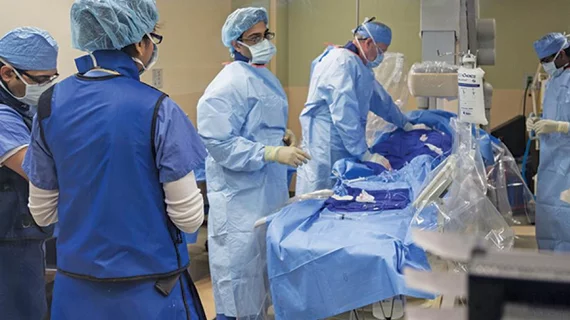Operators trained in the hybrid approach to PCI of chronic total occlusions (CTOs) demonstrated technical and procedural success rates of 87 percent and 85 percent, respectively, in a multicenter international trial.
In-hospital complications were 3 percent, which the researchers deemed “acceptable” considering the high-risk patient population. Forty-three percent of the 3,055 patients had diabetes, 46 percent had a previous myocardial infarction and 65 percent had undergone PCI previously.
“The overall complication rate was 3 percent, and complications occurred less frequently in technically successful procedures (2.2 percent vs. 7.9 percent; p < 0.0001),” wrote lead author Peter Tajti, MD, and colleagues in JACC: Cardiovascular Interventions. “The risk for complications was higher in more complex lesions and with use of advanced crossing techniques (which were more commonly used for more complex lesions). This highlights the importance of weighing the risks and benefits of the procedure, both during discussions with patients and family and during the procedure itself.”
The hybrid approach, according to the authors, involves “dual coronary injection, careful and structured review of the angiogram, and flexibility,” as well as the use of three different crossing strategies.
Tajti et al. found more than one crossing strategy was required in 40.9 percent of cases. In addition, they noted there is evidence that procedural success is tied to patient volume and whether the operator is trained in the hybrid approach, suggesting clinician experience is an important predictor of outcomes.
“Hence, CTO PCI should be performed by experienced operators at dedicated centers to achieve optimal results,” the researchers wrote.
CTOs were defined as coronary lesions with Thrombolysis in Myocardial Infarction (TIMI) antegrade flow grade 0 for at least three months. Technical success involved restoring TIMI antegrade flow to grade 3, while procedural success was defined as technical success without in-hospital complications.
In a related editorial, Gregg W. Stone, MD, said the riskiness of these operations is reflected in their outcomes. They often take longer than routine PCIs and procedural duration comes with its own risks.
“Procedural complications are now more frequent after CTO PCI than non-CTO PCI, and along with contrast nephropathy, bleeding, radiation exposure, and costs must be taken into account when considering the risk-benefit balance of complex CTO procedures,” wrote Stone, with Columbia University Medical Center and the Cardiovascular Research Foundation.
“Acknowledging the present report as the magnum opus of CTO PCI technique, the focus now needs to shift to 1) appropriate patient selection and demonstration of clinical use; and 2) ensuring that most patients with CTOs who can derive benefit are provided access to expert care. Potential benefits of CTO PCI include reduced ischemia and angina, improved left ventricular function and exercise capability, improved quality of life, and enhanced survival.”
Stone said there is a need for a sham-controlled trial—with medical therapy in both arms—evaluating CTO PCI’s impact on quality of life and mortality to at least one year. He acknowledged such a trial would be difficult and expensive to conduct, but said it is necessary to prove CTO PCI deserves widespread adoption.
“Until such a definitive trial is performed, a growing choir of increasingly vocal critics doubting the use and cost-effectiveness of CTO PCI should be anticipated,” Stone wrote.
In addition, Stone said training more operators and improving PCI equipment could improve procedural success rates of expert and non-expert clinicians alike. These gains would also allow patients to access quality interventions in a broader geographic area, he added.

